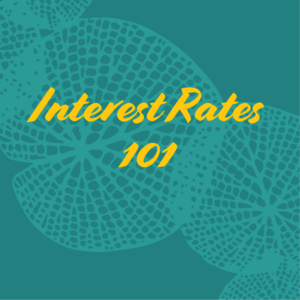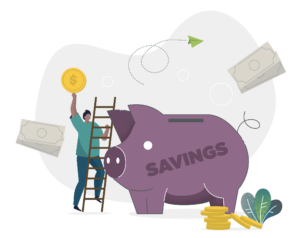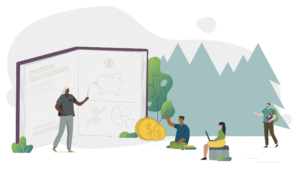What You’ll Learn
- In this article, you’ll get the basics of interest rates explained—what they are, how they are determined, and how rates can be impacted by both the economy and the Federal Reserve.
 Whether you’re saving for a rainy day, buying a home, or just trying to make sense of your credit card statement, interest rates are part of our financial lives. Sure, most of us understand that when we put money in our savings account, we earn interest. On the other hand, when we borrow money, we pay interest to our credit union or bank. But what do U.S. Treasury notes or the Wall Street Journal Prime Rate have to do with the interest you earn or pay? It can all get a bit confusing, even for our more financial-savvy members. So, we’ve put together this short FAQ to cover the basics of how interest rates work—and why they go up and down.
Whether you’re saving for a rainy day, buying a home, or just trying to make sense of your credit card statement, interest rates are part of our financial lives. Sure, most of us understand that when we put money in our savings account, we earn interest. On the other hand, when we borrow money, we pay interest to our credit union or bank. But what do U.S. Treasury notes or the Wall Street Journal Prime Rate have to do with the interest you earn or pay? It can all get a bit confusing, even for our more financial-savvy members. So, we’ve put together this short FAQ to cover the basics of how interest rates work—and why they go up and down.
Q: What is an interest rate?
Think of an interest rate as the price of money. If you’re borrowing, it’s what you pay for using your lender’s money. If you’re saving, it’s what you earn for letting the bank use your money. Interest rates are usually a percentage that tells you how much extra you’ll pay or earn over a period of time.
Q: What is the difference between interest earned from a savings account and interest paid on a loan?
When you save money in an account like savings or CD, the bank pays you interest for keeping your money there. On the other hand, when you take out a loan, you’re the one paying interest to the bank for letting you use its money. In short, you earn interest on savings, but you pay interest on loans.
Q: What’s the difference between a fixed interest rate and a variable interest rate?
A fixed interest rate offers stability and predictability over the duration of a loan’s term. Whether you’re dealing with a mortgage, personal loan, or any other form of credit, if it has a fixed rate, that means the interest rate is set to remain unchanged for the entirety of the loan period or a specified part of it. This consistent rate shields you from market fluctuations, ensuring your loan payments are the same month after month, which is helpful when it comes to budgeting. Fixed rates are generally set higher at the outset compared to variable rates, reflecting the lender’s need to balance the risk of potential future increases in market rates.
A variable interest rate—sometimes called an adjustable rate—fluctuates over time, mirroring changes in market index rates, such as the prime rate. This means that your interest rate (and as a result, your payments) can rise or fall. Variable rates can sometimes be lower than fixed rates, but it’s good to keep in mind that your rate could potentially increase over time, costing you more money. Of course, if rates go down, you could also end up paying less interest.
See how variable credit card rates have gone up and down over the past decades.
Q: How do credit unions determine their interest rates?
Credit unions like Salal set their rates by looking at several factors: how much it costs them to operate, what they earn from loans, what other banks and credit unions are charging, and what the Federal Reserve’s guidelines are. Since credit unions are owned by their members, they usually aim to give better savings rates and lower loan rates because their ultimate goal is to serve their members, not to make a profit for shareholders.
Q: What causes interest rates to go up and down?
Interest rates fluctuate mainly due to the economy’s health (like changes in inflation or employment rates) and policy changes from central banks like the Federal Reserve. If the economy is doing well, rates might go up to prevent overheating. If it’s not, rates might go down to stimulate spending and borrowing.
The Federal Reserve has a big influence on everyone’s interest rates. For example, in the wake of the 2008 financial crisis, the Fed brought interest rates very low in an effort to give the economy a boost. Starting in 2022, we saw the Fed begin to raise rates at a historically fast pace in an effort to slow inflation. Now in 2024, the Fed has signaled that it might be done with rate hikes for a while, and might even start cutting rates. This, of course, has begun to send savings and lending rates slightly down from their peaks in 2023.
 Q: What is the difference between interest rate vs. APY on a savings account?
Q: What is the difference between interest rate vs. APY on a savings account?
The interest rate on a savings account is the basic percentage you’ll earn over a year. The APY (Annual Percentage Yield), however, includes how often that interest is compounded—that is, how often the earned interest is added to your balance to earn more interest. APY gives you a more accurate picture of what you’ll earn because it considers the compounding effect.
Use our compound interest calculator to estimate how much you can grow your savings over time.
Q: Do all savings accounts have variable interest rate?
No. Some savings accounts have fixed interest rates. Standard savings accounts and money market accounts typically do have variable interest rates that can—and will—change over time based on the economic and government policy influences we talked about above.
However, certificates of deposit (CDs) usually provide fixed interest rates for the duration of the CD term. When you open a CD, you agree to leave your money in the credit union or bank for a set period, ranging from a few months to several years. In return, you earn interest at the set rate that doesn’t change over the duration of the term. This makes CDs an attractive option for secure and predictable savings growth that isn’t impacted by changing interest rates. A fixed-rate CD will often give you a better rate, but you need to leave your money in the CD for the full term. If you take your money out of the CD before the end of the term, you may lose some of the interest you would have earned had you let the CD reach maturity.
It’s also good to keep in mind that the fixed rates offered for CDs will change over time based on the same influences that impact variable rates. For example, say you open a 6-month CD at a given fixed rate. When that CD reaches maturity 6 months later, if you wanted to open a new 6-month CD, the rate being offered for 6-month CDs might have gone up or down in the half year since you opened your original CD.
Visit our Save page to see all the fixed and variable-rate savings tools we offer here at Salal.
Q: What is the difference between interest rate vs. APR on a loan or credit card?
The interest rate on a loan or credit card is simply the percentage of the loan amount you’ll pay in interest. APR (Annual Percentage Rate), on the other hand, includes the interest rate plus other charges or fees you’ll pay to get the loan, like origination fees or private mortgage insurance. So, APR gives you a fuller picture of the total cost of borrowing the money each year.
In the case of credit cards, the Truth in Lending Act does require credit card issuers to list their interest rates as APRs. But credit card APR doesn’t include any fees you might pay (annual fees, balance transfer fees, etc.). This means your credit card interest rate and APR are usually the same.
Q: Why is my payment on my fixed-rate loan starting out with more of my payment going to interest than principal?
When you first get a loan, your balance is high, which means you are paying more interest. This means most of your monthly payment goes to cover the interest, and only a little goes towards reducing the principal (the actual amount you borrowed). As time goes on and you keep making your payments, the principal amount gets smaller. This means you owe less interest, so more of your payment goes towards paying off the principal. Near the end of your loan, your interest is much lower, so most of your payment is used to finish paying off the principal. This whole process is called amortization.
Lenders calculate your monthly payment using a special formula. This makes sure that the right amount of your payment goes towards interest and principal, to pay off the loan completely by the end of your loan term. You can use our amortization calculator to see how much you would pay each month for different loan amounts, lengths of time, and interest rates.
Q: How do you make a principal-only payment on my loan?
Principal payments, also known as principal-only payments, are extra payments made on a loan or mortgage, over and above your regular scheduled payment. This concept is relatively straightforward but can have a big impact on how quickly you pay off your loan and how much you end up paying in the long run. To learn more, see our article on How to Make an Additional Principal Payment on Your Loan or Mortgage.
It’s good to note that credit unions often feature loans that don’t have prepayment penalties. A prepayment penalty is a fee that some lenders charge if you pay off all or part of your mortgage early.
Check out this prepayment analysis calculator to estimate how much you could save by pre-paying your loan.
 Q: How does the 10-Year Treasury note affect interest rates?
Q: How does the 10-Year Treasury note affect interest rates?
The 10-Year Treasury note is like the North Star for interest rates: when its yield goes up, so do most other rates, including mortgages. It’s a key indicator that investors use to gauge the economy’s health and future interest rate expectations. Since it’s considered a safe investment, its yield reflects the confidence (or lack thereof) in the economy.
Track the change of 10-Year Treasury note rate over time.
Q: Why are mortgage rates different than other lending rates?
Mortgage rates are often influenced by the 10-year Treasury note because they’re typically paid back over a long time, just like how the Treasury note is a long-term investment. Other loans, like car loans or personal loans, are shorter-term, so they’re influenced more by different factors, including the Federal Reserve’s rates and competition between lenders.
We’re Here to Help
Have more questions about interest rates—or any other financial topic? We’re always here to help. Visit our Contacts page to see all the ways you can get ahold of us. You can also visit our Resources page to find easy-to-follow tutorials, financial tips, and more info about all the features and benefits available to Salal members.

